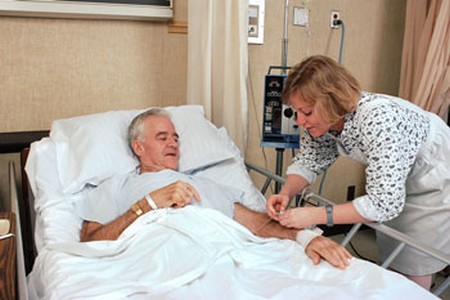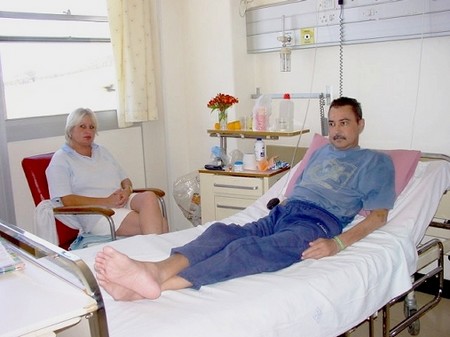Most homes have low beds. These make nursing difficult, mainly because the risk of back strain for the helper is greater. Bed blocks can be placed under the bed legs to increase the height: they must be checked frequently as they may become unstable.
If the patient is being nursed in a double bed it is more difficult to care for him, especially if he cannot get out of bed. If there is a single bed available it might be worth trying to persuade him to move into that. However, having someone sharing the bed may alleviate distress and allay fears, particularly following a stroke or if a patient is handicapped; and any nursing disadvantage will probably be outweighed by the advantage of having another person at hand during the night.
Adjustable beds which can be raised or lowered by a winding handle or hydraulic foot pedal, are expensive and usually found only in hospitals. The bed can be lowered when the patient is getting in or out and raised for bed making.
Bedmaking
There are many different ways of making a bed, but certain rules apply at all times:
- roll up your sleeves and remove watches and rings to prevent injury to the patient and damage to your personal possessions
- strip the bed neatly (see below)
- mitre corners
- make sure there are enough bedclothes at the top of the bed to fold back and still cover the patient when he lies down
- loosen the bedclothes over the patient’s feet so that he can move his toes freely. To make a bed, you will need:
- two sheets
- an underblanket
- two top blankets
- an eiderdown in cold weather
- as many pillows and pillow cases as the patient wants or his condition dictates
- two chairs back to back.
If it is necessary to protect the mattress, you will also need a plastic sheet to go underneath the bottom sheet. Where a draw-sheet is used, a piece of plastic sheeting can also be placed between that and the bottom sheet.
Stripping a bed
Two people should work together to strip a bed efficiently. Fold each layer of bedlinen neatly into three before removing it from me bed. Make sure the folded linen is placed tidily on two chairs and is not touching the floor, and that all the items are piled up in the order required to remake the bed.
Using a continental quilt
Continental quilts (duvets) are increasing in popularity: they are warm, light, mould themselves to the body and do not slip off the bed like an eiderdown. They come filled with down, a mixture of feather and down, or man-made fibres, and have washable covers. Quilts come in various sizes: use the largest available for the type of bed.
If a continental quilt suits the patient, bedmaking is greatly simplified. However, it is important to make the bed as often as you would normally. The patient needs the pleasure of returning to a freshly made bed in the same way as any other patient, and, although it is tempting to think that a quilt merely needs to be plumped up, the filling does tend to collect at the foot end, so the quilt will need a thorough shaking.
Change the bottom sheet in the usual way – often a fitted sheet is used. The quilt replaces all the bedclothes on top of the patient. Shake the quilt so that its filling is evenly distributed and let it fall neatly on top of the pillows and bottom sheet. Avoid using a counterpane as it flattens the quilt and reduces the warmth created by the air trapped within the filling.
Further Readings:

